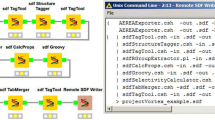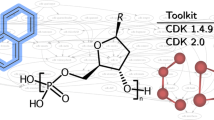Summary
Workflow technology is being increasingly applied in discovery information to organize and analyze data. SciTegic's Pipeline Pilot is a chemically intelligent implementation of a workflow technology known as data pipelining. It allows scientists to construct and execute workflows using components that encapsulate many cheminformatics based algorithms. In this paper we review SciTegic's methodology for molecular fingerprints, molecular similarity, molecular clustering, maximal common subgraph search and Bayesian learning. Case studies are described showing the application of these methods to the analysis of discovery data such as chemical series and high throughput screening results. The paper demonstrates that the methods are well suited to a wide variety of tasks such as building and applying predictive models of screening data, identifying molecules for lead optimization and the organization of molecules into families with structural commonality.
Similar content being viewed by others
Abbreviations
- MCSS:
-
maximal common substructure search
- ECFP:
-
extended connectivity fingerprints
- FCFP:
-
functional class fingerprints
- MDDR:
-
MDL drug data report
- WDI:
-
world drug index
- CATS:
-
chemically advanced template search
- BKD:
-
binary kernel discrimination
- CDK2:
-
cyclin-dependent kinase 2
- DHFR:
-
escherichia coli dihydrofolate reductase
References
SciTegic, Inc. 10188 Telesis Court, Suite 100, San Diego, CA 92121, USA, http://www.scitegic.com/products_services/pipeline_pilot.htm
Todeschini, R. and Consonni, V., Handbook of Molecular Descriptors, Wiley-VCH, Weinheim, Germany, 2000.
Mark Johnson, M., Maggiora, G., (Eds.) Concepts and Applications of Molecular Similarity. Wiley, New York, 1990.
McGregor, M.J. and Pallai, P.V., Clustering of large databases of compounds: Using the MDL ‘keys’ as structural descriptors, J. Chem. Inf. Comput. Sci., 37 (1997) 443–448.
Breiman, L., Friedman, J.H., Olshen, R.A. and Stone, C.J., Classification and Regression Trees, Wadsworth and Brooks/Cole, Monterey, CA, 1984.
Dubois, J. E., In Chemical Applications of Graph Theory, In Balaban, A.T. (Ed.) Academic Press, London, 1976, p. 161.
Randic, M., Fragment search in acyclic structures, J. Chem. Inf. Comput.Sci., 18 (1978) 101–107.
Willett, P., A screen set generation algorithm, J. Chem. Inf. Comp. Sci., 19 (1979) 159–162.
Marie, T., Gannon and Willett, P., Sampling considerations in the selection of fragments screens for chemical substructure search systems, J. Chem. Inf. Comp. Sci., 19 (1979) 251–253.
Willett, P., The effect of screen set size on retrieval from chemical substructure search systems, J. Chem. Inf. Comp. Sci., 19 (1979) 253–255.
Schubert, W. and Ugi, I., Constitutional symmetry and unique descriptors of molecules, J. Amer. Chem. Soc., 100 (1978) 37–41.
Bremser, W., HOSE – A novel substructure code, Anal. Chim. Acta, 103 (1978) 355–365.
Bender, A., Mussa, H.Y., Glen, R.C. and Reiling, S. Molecular similarity searching using atom environments, information-based feature selection, and a naive Bayesian classifier, J.Chem. Inf. Comput. Sci., 44 (2004) 170–178.
Morgan, H. L., The generation of a unique machine description for chemical structures-A technique developed at chemical sbstracts service, J. Chem. Doc., 5 (1965) 107–112.
Weininger, D., Weininger, A. and Weininger, J.L., SMILES. 2. Algorithm for generation of unique SMILES notation, J. Chem. Inf. Comp. Sci., 29 (1989) 97–101.
Rogers, D. and Hahn, M., Extended connectivity fingerprints, J. Chem. Inf. Model., in preparation.
Bender, A. and Glen, R.C., Molecular similarity: A key technique in molecular informatics, Org. Biomol. Chem., 2 (2004) 3204–3218.
Hert, J., Willett, P., Wilton, D.J., Acklin P., Azzaoui, K., Jacoby, E. and Schuffenhauer, A., Comparison of fingerprint-based methods for virtual screening using multiple bioactive reference structures, J. Chem. Inf. Comput. Sci., 44 (2004) 1177–1185.
Everitt and Brian S., Cluster Analysis, Edward Arnold, A division of Hodder & Stoughton, London, 1997.
Kaufman, L. and Rousseeu, P., Finding Groups in Data, Wiley-Interscience, New York, 1990.
Hassan, M., Bielawski, J.P., Hempel, J.C. and Waldman, M., Optimization and visualization of molecular diversity and combinatorial libraries, Molecular Diversity, 2 (1996) 64–74.
Asinex, Incorporated, 6 Schukinskaya St, Moscow 123182, Russia; http://www.asinex.com
Raymond, J.W., Gardiner, E.J. and Willett, P. Rascal, calculation of graph similarity using maximum common edge subgraphs, Comput. J., 45 (2002) 631–644.
Raymond, J.W., Gardiner, E.J. and Willett, P., Heuristics for similarity searching of chemical graphs using a maximum common edge subgraph algorithm, J. Chem. Inf. Comput. Sci., 42 (2002) 305–316.
Xia, X., Maliski E.G., Gallant, P. and Rogers, D., Classification of kinase inhibitors using a Bayesian model, J. Med. Chem., 47 (2004) 4463–4470.
Hert, J., Willett, P., David J.W., Acklin P., Azzaoui K., Jacoby E. and Schuffenhauer A., New methods for ligand-based virtual screening: Use of data fusion and machine learning to enhance the effectiveness of similarity searching, J. Chem. Inf. Model. (2006), in press.
Robertson, S.E. and Sparck J.K., Relevance weighting of search terms, J. Amer. Soc. Inform. Sci., 27 (1976) 129–146.
Avidon, V.V., Arolovich, V.S., Kozlava, S.P. and Piruzyan, L.A., Statistical study of information file on biologically active compounds. II. Choice of decision rule for biologically active prediction, Khim. Farm. Zh., 12 (1978) 88–93.
Hert, J., Willett, P., Wilton, D.J., Acklin P., Azzaoui, K., Jacoby E. and Schuffenhauer A., Comparison of topological descriptors for similarity-based virtual screening using multiple bioactive reference structures, Org. Biomol. Chem., 2 (2004) 3256–3266.
Barnard Chemical Information Ltd. is at http://www.bci.gb.com/
Daylight Chemical Information Systems, 27401 Los Altos, Suite 360, Mission Viejo, CA, USA 92691; http://www.daylight.com
Tripos Inc. is at http://www.tripos.com
Schuffenhauer, P., Floersheim, P., Acklin, P. and Jacoby, E., Similarity metrics for ligands reflecting the similarity of the target proteins, J. Chem. Inf. Comput. Sci., 43 (2003) 391–405.
Schneider, G., Neidhart, W., Giller, T. and Schmid, G., Scaffold-hopping by topological pharmacophore search: A contribution to virtual screening, Angew. Chem. Int. Ed. Engl., 38 (1999) 2894–896.
The MDL Drug Data Report database is available from MDL Information Systems Inc. at http://www.mdli.com/
Bemis, G.M. and Murcko, M.A., The properties of known drugs. 1. Molecular frameworks, J. Med. Chem., 39 (1996) 2887–2893.
National Cancer Institute database, available at http://dtp.nci.nih.gov/
Sielecki, T.M., Boylan, J.F., Benfield, P.A. and Trainor, G.L., Cyclin-dependent kinase inhibitors: Useful targets in cell cycle regulation. J. Med. Chem., 43 (2000) 1–18.
Buolamwini, J.K., Cell cycle molecular targets in novel anticancer drug discovery. Curr. Pharm. Des., 6 (2000) 379–392.
Meijer, L., Cyclin-dependent kinases inhibitors as potential anticancer, antineurodegenerative, antiviral and antiparasitic agents, Drug Resist. Updates, 3 (2000) 83–88.
Sausville, E.A., Johnson, J., Alley, M., Zaharevitz, D. and Senderowicz, A.M., Inhibition of CDKs as a therapeutic modality, Ann. N. Y. Acad. Sci., 910, Colorectal Cancer (2000) 207–222.
Mani, S., Wang, C., Wu, K., Francis, R. and Pestell, R., Cyclin-dependent kinase inhibitors: Novel anticancer agents. Exp. Opin. Invest. Drugs 9 (2000) 1849–1870.
Fischer, P.M. and Lane, D.P., Inhibitors of cyclin-dependent kinases as anti-cancer therapeutics, Curr. Med. Chem., 7 (2000) 1213–1245.
Senderowicz, A.M., Small molecule modulators of cyclin-dependent kinases for cancer therapy, Oncogene, 19 (2000) 6600–6606.
Senderowicz, A.M., Development of cyclin-dependent kinase modulators as novel therapeutic approaches for hematological malignancies. Leukemia, 15 (2001) 1–9.
Senderowicz, A.M., Cyclin-Dependent Kinase Modulators: A Novel Class of Cell Cycle Regulators for Cancer Therapy. In Cancer Chemotherapy and Biological Response Modifiers, Annual 19; Giaccone, G., Schilsky, R., Sondel, P., (Eds.), Elsevier Science: New York, 2001, pp 165–188.
Roy, K.K. and Sausville, E.A., Early development of cyclin dependent kinase modulators, Curr. Pharm. Des., 7 (2001) 1669–1687.
Fischer, P.M., Recent advances and new directions in the discovery and development of cyclin-dependent kinase inhibitors, Curr. Opin. Drug Discovery Dev., 4 (2001) 623–634.
Bradley, E.K., Miller J.L., Saiah, E. and Grootenhuis, P.D.J., Informative library design as an efficient strategy to identify and optimize leads: Application to cyclin-dependent kinase 2 antagonists, J. Med. Chem., 46 (2003) 4360–4364.
Parker, C.N., McMaster university data-mining and docking competition. Computational models on the catwalk, J. Biomol. Screening, 10 (2005) 647–649.
Rogers, D., Brown, R.D and Hahn, M., Using extended-connectivity fingerprints with laplacian-modified Bayesian analysis in high-throughput screening follow-up, J. Biomol. Screening, 10 (2005), 682–686.
Klon, A.E., Glick, M., Thomas, M., Acklin, P. and Davies, J. W., Finding more needles in the haystack: A simple and efficient method for improving high-throughput docking results, J. Med. Chem., 47 (2004) 2743–2749.
Klon, A.E., Glick, M. and Davies, J.W., Combination of a Naive Bayes classifier with consensus scoring improves enrichment of high-throughput docking results, J. Med. Chem., 47 (2004) 4356–4359.
Author information
Authors and Affiliations
Corresponding author
Rights and permissions
About this article
Cite this article
Hassan, M., Brown, R.D., Varma-O’Brien, S. et al. Cheminformatics analysis and learning in a data pipelining environment. Mol Divers 10, 283–299 (2006). https://doi.org/10.1007/s11030-006-9041-5
Received:
Accepted:
Published:
Issue Date:
DOI: https://doi.org/10.1007/s11030-006-9041-5




